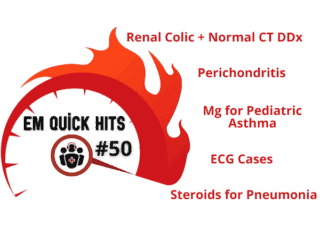Best Case Ever 22: Nonconvulsive Status Epilepticus (NCSE)
In the first of our series on Best Case Ever of 'Carr's Cases' we have, the legend himself, Dr. David Carr. This series will run on the theme of interesting diagnoses that we don't think of too often, but that are not as rare as we might think and can make a significant difference to your patient's outcome if you pick up on them early - and maybe even make you look as smart as David! Dr. Carr will be highlighted in our upcoming episode on Whistler's Update in EM Conference highlights 2014 when he will be speaking about his approach to the shocky patient as well as the controversial management of submassive pulmonary embolism. He will be featured along with Dr. Lisa Thurgur speaking about lipid emulsion therapy and other toxicologic goodies and Joel Yaphe will give us his take on the best of the EM literature from 2013 including the TTM trial, tranexamic acid for epistaxis, return to sport after concussion guidelines and more. Please go to the 'Next Time on EM Cases' page to submit your question about these topics.










